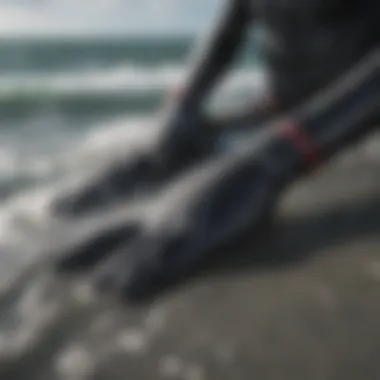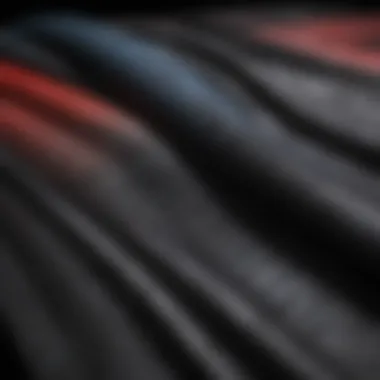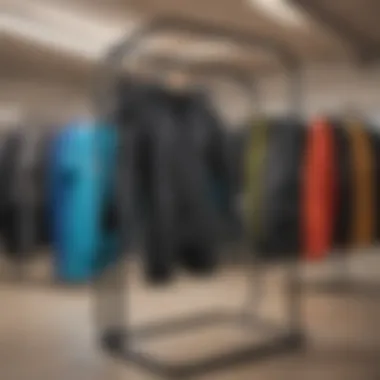XL Short Wetsuits: The Ultimate Kitesurfing Guide


Intro
When selecting gear for kitesurfing, the type of wetsuit plays a crucial role in performance and comfort. Among the available options, XL short wetsuits have gained popularity for their unique blend of functionality and flexibility. This article explores various aspects of XL short wetsuits tailored for kitesurfing enthusiasts. We will discuss features, advantages, and essential maintenance tips that can help both beginners and experienced riders make informed decisions about their wetsuit choices.
Understanding sizing is one critical point. An ill-fitting wetsuit can lead to discomfort and decreased performance in the water. We will address the importance of accurate measurements to choose the right fit. Moreover, material options for short wetsuits can impact the overall experience, influencing warmth, durability, and freedom of movement. This guide will highlight various materials and their specific benefits as well.
Performance aspects are another vital consideration. A quality wetsuit enhances agility and reduces drag, allowing for more dynamic movement on the water. We will cover how different designs affect kitesurfing dynamics and which features to look for in an XL short wetsuit.
Finally, we will provide practical tips for maintaining your wetsuit, ensuring longevity and optimal performance over time. Selecting the right wetsuit is not just about comfort; it is about enhancing your overall kitesurfing experience. Let's delve into the specifics, starting with an essential review of the equipment.
Understanding Wetsuit Sizing
Understanding wetsuit sizing is crucial for anyone serious about kitesurfing. Choosing the correct size impacts comfort, mobility, and overall performance on the water. An inappropriate fit can lead to discomfort, restrict movement, and even affect thermal insulation. This section will discuss how accurate sizing, particularly of XL short wetsuits, plays a significant role in enhancing the kitesurfing experience.
Defining Short Wetsuits
XL short wetsuits are specifically designed to cater to individuals who require a larger fit while offering a short style that facilitates movement and increases comfort. This type of wetsuit typically has short legs and arms, minimizing bulk without sacrificing essential coverage. It maintains core warmth, which is crucial when engaging in rigorous water sports such as kitesurfing. The XL designation signifies a specific range of measurements that are tailored to accommodate larger body types.
Importance of Accurate Sizing
Accurate sizing of XL short wetsuits cannot be overstated. An ill-fitting wetsuit can lead to water entering the suit, which results in a loss of heat. This is particularly detrimental during longer sessions in cooler waters. Moreover, an appropriate fit ensures that the wetsuit remains snug against the body, allowing for better insulation and comfort. It also aids in the free movement of the arms and legs, which is critical for effective kitesurfing maneuvers.
Measuring for the Right Fit
To achieve the right fit, precise measurement is essential, focusing on three key areas: height, weight, and body proportions.
Height Measurement
Height measurement is the starting point for finding the suitable wetsuit size. To accurately measure, one should stand straight against a wall and mark the height. This measurement is vital as it dictates the overall length of the wetsuit. An appropriate height measurement ensures that the wetsuit does not squeeze or be excessively loose in certain areas, providing a balanced fit. A well-fitted wetsuit enhances movement without causing constriction.
Weight Considerations
Weight considerations are another critical aspect that influences wetsuit sizing. Different manufacturers provide size charts that correlate weight ranges to wetsuit sizes. An individual's weight not only impacts the fit but also how buoyant the wetsuit is in water. A suitable weight measurement helps ensure that the wetsuit remains functional and does not cause drag while kitesurfing. Keeping within the weight parameters defined by the brand maximizes performance and comfort on the water.
Body Proportions
Body proportions play a substantial role in determining the correct fit of an XL short wetsuit. Different individuals have unique shapes, and understanding where your specific measurements fall on the sizing chart is key. Some may have a longer torso while others may have longer limbs. It is essential to consider these variations as they can affect the overall fit and functionality of the wetsuit. A well-proportioned wetsuit caters to the individual's body shape, enhancing comfort and mobility throughout a session.
Materials Used in Wetsuits
The materials utilized in wetsuits significantly impact the functionality and performance of kitesurfing gear. Understanding these materials is essential for making informed choices. Whether you prioritize warmth, flexibility, or environmental considerations, the type of material will guide your decision. Each material offers distinct features that can enhance or hinder your kitesurfing experience.
Neoprene Types and Features
Standard Neoprene
Standard neoprene is the most common material used in wetsuits. It provides a good balance between insulation and flexibility. This type offers a decent level of thickness that keeps the wearer warm in cooler waters. Its key characteristic is a good level of buoyancy and insulation.


However, one of the unique features of standard neoprene is its limited stretch. While it moves with the body to an extent, it does not conform like more advanced materials. This can be a disadvantage for kitesurfers who require maximum movement and agility while riding. Ultimately, while standard neoprene is a solid option for beginners, those looking for enhanced performance may need to explore alternatives.
Super Stretch Neoprene
Super stretch neoprene is an advanced material that offers enhanced flexibility and mobility. This type allows for a wider range of motion, which is critical for kitesurfing. The key characteristic of super stretch neoprene is its ability to expand, making it ideal for dynamic activities.
A unique feature of this material is its lightweight nature. This provides a significant advantage, especially in warmer temperatures. However, super stretch neoprene might not offer the same level of durability as standard neoprene. It is essential to evaluate your kitesurfing conditions before choosing this option, as the trade-off between durability and flexibility may not suit all users.
Eco-Friendly Alternatives
Eco-friendly alternatives to traditional neoprene are gaining traction in the kitesurfing community. These materials often incorporate natural rubber or recycled materials, contributing to environmental sustainability. The key characteristic here is their reduced ecological footprint, making them appealing to environmentally conscious riders.
A unique feature of eco-friendly alternatives is their comparable performance levels to standard neoprene. Many models offer good insulation and flexibility without compromising functionality. However, they may come at a slightly higher price point, which can deter some users. Overall, choosing eco-friendly materials aligns with a sustainable lifestyle, making these options worth considering for kitesurfers who prioritize both performance and the environment.
Durability and Longevity of Materials
The durability and longevity of a wetsuit are crucial factors to consider. Materials like standard neoprene are favored for their ability to withstand wear and tear in rugged conditions. In contrast, super stretch neoprene may require more careful handling to maintain its structure over time. Eco-friendly alternatives, while promising, should also be evaluated for long-term durability, as these characteristics can affect overall satisfaction with the wetsuit.
Performance Aspects of Short Wetsuits
Performance is a critical factor when it comes to selecting a wetsuit, especially for kitesurfers who demand both functionality and comfort in varying water conditions. XL short wetsuits are designed to enhance the overall experience while allowing freedom of movement. This section highlights essential aspects such as thermal regulation, flexibility, and water resistance, which contribute significantly to higher performance on the water.
Thermal Regulation
Thermal regulation is vital in maintaining body temperature during kitesurfing. Water temperatures can vary widely, and without proper insulation, a kitesurfer may face the risk of hypothermia. XL short wetsuits offer a balance between warmth and breathability. They are generally crafted with materials like neoprene, which provides adequate insulation while allowing excess heat to escape.
A wetsuit's thickness often affects its thermal efficiency. For instance, a thicker wetsuit provides better insulation for colder waters, whereas a thinner one offers agility in warmer conditions. Effective thermal regulation not only enhances comfort but also allows for better focus on performance.
Proper thermal management allows kitesurfers to enjoy longer sessions without discomfort, ultimately improving their skill development.
Flexibility and Mobility
Flexibility is paramount in kitesurfing. The ability to move freely is essential for executing maneuvers and maintaining balance. XL short wetsuits usually incorporate features like super-stretch neoprene, which facilitates a greater range of motion. Tailored constructions in the shoulder and arm areas prevent restrictions, thus allowing more dynamic movements.
Additionally, well-designed wetsuits take into account the position of seams. Flatlock seams or glued and blind-stitched seams ensure that there are no uncomfortable pressure points. Enhanced flexibility contributes directly to a kitesurfer's ability to react swiftly to changing conditions on the water, making it an essential aspect of performance.
Water Resistance and Drying Time
Water resistance in a wetsuit determines how effectively it keeps water out. XL short wetsuits crafted from high-quality materials feature sealed seams and watertight constructions that significantly reduce water entry. This feature ensures that kitesurfers remain dry and can maintain their body heat during their time on the water.
Additionally, the drying time of a wetsuit is a practical consideration. After a session, a wetsuit that dries quickly can improve convenience and comfort for the next use. Many high-quality models are designed to shed water efficiently, allowing them to dry within a few hours. Choosing a wetsuit that balances water resistance with quick drying capabilities means that kitesurfers spend less time in a damp suit.
In summary, the performance aspects of XL short wetsuits—thermal regulation, flexibility, and water resistance—play essential roles in the overall kitesurfing experience. Proper consideration of these factors can lead to better performance, longer sessions, and increased enjoyment on the water.
Advantages of Short Wetsuits for Kitesurfing
Understanding the advantages of XL short wetsuits is vital for anyone looking to enhance their kitesurfing experience. These wetsuits provide unique benefits that cater specifically to the needs of kitesurfers, where comfort and performance are paramount. With features that prioritize mobility and breathability, XL short wetsuits serve as an essential piece of gear for both beginners and experienced kitesurfers alike.


Enhanced Mobility
Mobility is one of the standout features of XL short wetsuits. Designed to allow maximum freedom of movement, they help athletes perform at their best without restriction. Kitesurfing requires agility and quick reflexes, particularly when navigating strong winds and waves. Short wetsuits cover the torso, providing warmth, while allowing the legs and arms to move freely.
- Flexibility: The strategic design of XL short wetsuits emphasizes flexibility. Materials such as super stretch neoprene contribute to this, making it easier to execute maneuvers.
- Range of Motion: With shorter sleeves and legs, these wetsuits do not inhibit your arm or leg movements, allowing for a natural range of motion. This is critical when you're managing the kite and board simultaneously.
- User Confidence: Enhanced mobility translates to confidence on the water. Knowing you can move freely makes a significant difference in performance and enjoyment.
Breathability and Comfort
Breathability is another prime advantage of XL short wetsuits. These suits are engineered to maintain a comfortable body temperature and prevent overheating during intense activity. Kitesurfing often involves extended periods in strong sunlight, which can be draining.
- Moisture Management: Quality wetsuits incorporate materials that wick moisture away from the body. This property helps regulate temperature and keep you comfortable as you engage in rigorous physical activity.
- Comfort Fit: A well-fitted XL short wetsuit should feel like a second skin. The right materials coupled with precise sizing ensure that you stay comfortable throughout your session on the water.
- Reduced Chafing: The design of these wetsuits minimizes skin irritation by providing smooth seams and comfortable liner materials. This is especially important for extended sessions wherein prolonged contact can cause discomfort.
"Choosing the right wetsuit can elevate your kitesurfing experience to new heights. Comfort and performance go hand in hand."
In summary, the advantages of XL short wetsuits for kitesurfing cannot be overstated. Enhanced mobility and breathability, combined with comfort, make these wetsuits a practical choice for any kitesurfer aiming to maximize their time on the water. The right wetsuit can transform a good session into a great one, allowing you to focus entirely on the joy of kitesurfing.
Choosing the Right Short Wetsuit
Selecting the proper XL short wetsuit is not a trivial process. It can significantly impact your overall performance while kitesurfing. A well-fitting wetsuit enhances comfort, flexibility, and warmth. Conversely, the wrong choice can lead to discomfort and limit your movement on the water. Therefore, it is essential to consider various elements, including your personal needs and specific conditions you will encounter while kitesurfing.
Identifying Your Needs
Understanding your requirements is the first step in finding the right wetsuit. Pay attention to the climate where you will be kitesurfing. Are you in a warm area or a colder region? The water temperature plays a crucial role in determining the thickness of the wetsuit.
If you frequently kitesurf in colder waters, consider a wetsuit with added insulation. These provide warmth without compromising flexibility. If you mostly kite in warmer waters, a thinner wetsuit is more appropriate.
Also, consider your body type and preferences. Different kitesurfers have different needs. An athletic build may require a tighter fit to improve aerodynamics. A more relaxed fit might be suitable for those who prioritize comfort. Always consider your own needs and the typical conditions where you kite.
Evaluating Brands and Models
The market is flooded with various brands offering XL short wetsuits. Not all are created equal. Researching different brands helps you understand their unique features and benefits. Look for reputable brands that specialize in watersports, such as O'Neill, Rip Curl, and Xcel.
Each brand tends to have a specific focus. Some may prioritize durability, while others may excel in flexibility. Read reviews from other kitesurfers who have used those specific wetsuits. Online forums and communities, such as Reddit, can be valuable resources for gaining insights.
You should also check the warranty and after-sales support each brand offers. Longevity of a wetsuit is important, and knowing that you have support if issues arise is reassuring.
Price vs. Quality Considerations
When it comes to wetsuits, price can vary widely. It is often tempting to choose the cheapest option available. However, this might lead to compromises on quality. A low-cost wetsuit may lack the necessary durability or flexibility, hindering your performance.
On the other hand, expensive wetsuits do not always guarantee better quality. It is essential to strike a balance between budget and what you need. Identify the essential features you require and compare them against different price points.
To summarize, investing in a good wetsuit is investing in your kitesurfing experience. A high-quality wetsuit can last several seasons, making a higher initial cost worthwhile.
Care and Maintenance of Your Wetsuit
Proper care and maintenance of your wetsuit is crucial for its longevity and performance. Kitesurfing involves exposure to harsh conditions, including water, sun, and sand, which can wear out your equipment. Taking the time to properly maintain your XL short wetsuit not only extends its lifespan but also ensures that it continues to perform at optimal levels. Proper care can save you from frequent replacements and enhance your kitesurfing experience.


Proper Washing Techniques
Washing your wetsuit correctly is key to maintaining its integrity. After each kitesurfing session, it is essential to rinse your wetsuit in fresh water to remove salt, sand, and other residues. Salt can cause the material to degrade over time, while sand can create tiny abrasions on the fabric.
- Rinse Immediately: As soon as you finish your session, rinse your wetsuit thoroughly with fresh water.
- Use Cold Water: Always use cold water for rinsing. Hot water can damage the neoprene.
- Gentle Hand Wash: If necessary, use a mild wetsuit-specific soap for a more thorough clean. Avoid harsh detergents, as they can break down the material.
- Avoid Washing Machines: Never machine-wash or tumble dry your wetsuit. The agitation and high heat can cause irreversible damage.
- Air Dry Properly: Hang your wetsuit in a shaded area away from direct sunlight. Use a thick hanger to prevent stretching.
Incorporating these washing techniques ensures your wetsuit remains in good condition, providing both thermal insulation and comfort in the water.
Storage Recommendations
Proper storage of your wetsuit is equally important to extending its life. Incorrect storage can lead to misshaping, deterioration of materials, and unpleasant odors.
- Avoid Long-term Folding: Do not fold your wetsuit for extended periods. Instead, hang it on a wide hanger designed for wetsuits to maintain its shape.
- Store in a Cool, Dry Place: Choose a storage location that is cool and dry. Avoid areas with high humidity or extreme temperatures.
- Use Wetsuit Bags: If you have a wetsuit bag, it can be a good idea to store your wetsuit in it, as it provides extra protection against dust and insect damage.
- Check for Dampness: Ensure your wetsuit is completely dry before storing it away. Any moisture can lead to mold and mildew formation.
Correct care and maintenance of your wetsuit allows it to perform effectively, ensuring safety and comfort while kitesurfing.
By following these simple yet effective care and maintenance tips, kitesurfers can enjoy their XL short wetsuits for a longer time, ensuring they are always ready to hit the water.
Common Issues and Solutions
Understanding the common issues that can arise with XL short wetsuits is crucial for anyone involved in kitesurfing. This section highlights common challenges such as worn out seams and leaks, offering solutions to maintain your wetsuit effectively. Addressing these issues can significantly enhance the overall kitesurfing experience by ensuring that the gear remains functional and reliable. With the right knowledge, kitesurfers can avert potential inconveniences and extend the lifespan of their wetsuits.
Worn Out Seams
Worn out seams are a frequent issue kitesurfers encounter. With consistent use, especially in challenging water and weather conditions, seams may suffer stress and ultimately deteriorate. Recognizing the signs of seam wear is essential. Look for loose threads, fraying, or gaps where water can seep through. When seams start to fail, it is often a signal that repairs are needed.
Prevention is better than cure. Handling your wetsuit with care can reduce the risk of seam damage. Avoid pulling or stretching the wetsuit excessively. After every session, rinse your wetsuit with fresh water and lay it flat to dry in a shaded area. For immediate repairs, consider using specialized wetsuit seam glue if problems are detected early. Should the damage be extensive, a professional repair service might be necessary to avoid further complications.
Leaks and Repairs
Leaks in a wetsuit can be frustrating and uncomfortable. They often occur at the seams or entry points such as the neck, wrists, and ankles.
Identifying leaks usually requires some investigation. A common method to detect leaks is to perform a water test. Enter the water wearing the wetsuit and look for signs of cold spots where water is entering. Once identified, repairs can start.
- Patch Kits: Many manufacturers provide patch kits specifically for wetsuits. Applying a patch can resolve small leaks efficiently.
- Seam Sealer: Using a seam sealer can help close gaps in compromised seams.
- Professional Repair: When dealing with larger issues, a professional can ensure that the wetsuit is repaired to a high standard, preventing further wear and tear.
Addressing leaks promptly not only enhances comfort but also improves thermal efficiency. Being proactive in managing these common problems will help you enjoy your kitesurfing sessions without hindrances.
Culmination
In this guide, we have delved into various aspects of XL short wetsuits particularly focusing on their relevance for kitesurfers. Choosing the right wetsuit is not merely a matter of comfort; it directly impacts performance in the water. Understanding size and fit is crucial. An ill-fitted wetsuit can lead to discomfort and reduced mobility, whereas a correctly sized wetsuit enhances the overall kitesurfing experience.
Summarizing Key Points
The article has covered key elements such as:
- Understanding wetsuit sizing: It outlined the importance of selecting the appropriate size and measurements, focusing on height, weight, and body proportions.
- Materials used: Different types of neoprene were discussed, highlighting features that contribute to warmth, flexibility, and eco-friendliness.
- Performance aspects: We elaborated on thermal regulation, flexibility, and water resistance which are essential for effective kitesurfing.
- Advantages of XL short wetsuits: These include enhanced mobility and breathability which are vital for dynamic water sports.
- Choosing the right wetsuit: This covered identifying personal needs, evaluating brands, and understanding the balance between price and quality.
- Care and maintenance: Proper washing and storage techniques were provided to ensure the longevity of your wetsuit.
- Common issues and solutions: Recognizing wear and tear such as seams and leaks was addressed along with repair tips.
Encouraging Experience and Exploration
It is crucial for kitesurfers, whether beginners or seasoned enthusiasts, to not only equip themselves with the right gear but also to continually explore their own preferences and experiences. Engaging with the sport in different environments helps refine one’s skillset and comfort with equipment. This exploration could involve trying different kitesurfing locations or testing out various wetsuit brands and models.
Getting comfortable in the water is essential. Embrace the learning curve by seeking tips from fellow kitesurfers and participating in community discussions on forums like reddit.com. As you improve your skills, the right wetsuit will feel less like an accessory and more like a part of your body, enhancing your connection with the water and your enjoyment in kitesurfing.







